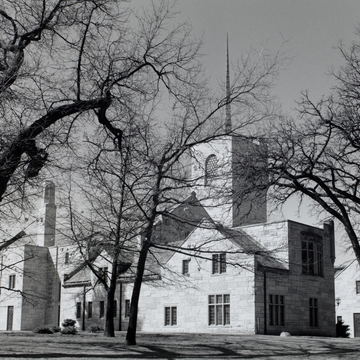Spurred on by the designs of Eliel Saarinen, Bertram G. Goodhue, and others, architects in America had an intense interest in how one might go about modernizing the medieval images of the Romanesque and the Gothic. The usual ingredients of this process consisted of great emphasis placed on plain, uninterrupted wall surfaces; in a reduction of the building's volume to basic geometric forms (cubes, rectangular volumes, etc.); a stress placed on the horizontal rather than the vertical; and a sparse use of ornament. When ornament was used it was abstracted and was meant to read as “modern.” The First Church of Christ Scientist carries out these modernizing principles: the horizontal stone wall surfaces predominate; the tower is a low rectangular volume with an abstracted suggestion of a turret on one corner, and a tiny spire is placed well into the center of the tower roof. Instead of pointed arched windows, the ones here have an inverted V-shape, and the round-arched doors and windows are delineated as shapes cut into the wall surface. This church building and the nearby Central Presbyterian Church were voted in 1939 as the “most noteworthy examples” of recent architecture in Des Moines.
You are here
First Church of Christ Scientist
If SAH Archipedia has been useful to you, please consider supporting it.
SAH Archipedia tells the story of the United States through its buildings, landscapes, and cities. This freely available resource empowers the public with authoritative knowledge that deepens their understanding and appreciation of the built environment. But the Society of Architectural Historians, which created SAH Archipedia with University of Virginia Press, needs your support to maintain the high-caliber research, writing, photography, cartography, editing, design, and programming that make SAH Archipedia a trusted online resource available to all who value the history of place, heritage tourism, and learning.





